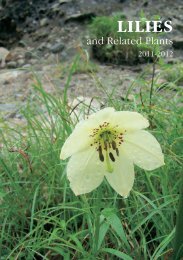LILIES - RHS Lily Group
LILIES - RHS Lily Group
LILIES - RHS Lily Group
Create successful ePaper yourself
Turn your PDF publications into a flip-book with our unique Google optimized e-Paper software.
European and Middle Eastern lilies<br />
With the Middle Eastern and European lilies, I have had moderate success.<br />
Lilium bulbiferum var. croceum grows and spreads very well, and so does<br />
Lilium pyrenaicum to a certain extent. However, both these species have for<br />
unknown reasons started declining in recent years, growing much shorter and<br />
rotting away.<br />
Likewise, Lilium martagon and L. candidum tend to rot very easily unless<br />
perfect drainage is provided. Lilium martagon seems to enjoy warm sunny sites<br />
rather than half shady and moist ones, where growth can often be destroyed by<br />
what seems to be fungus.<br />
Lilium carniolicum was unfortunately very sensitive to rotting, and even<br />
though perfect drainage was provided, my two bulbs rotted after a bit more than<br />
one season, not having flowered or produced any strong growth.<br />
The two bulbs of Lilium monadelphum that I acquired five years ago<br />
characteristically sulked for a season, producing no above ground growth, and<br />
then rotted away the following season. Lilium pomponium, a very nice rarity<br />
from the south of France seems to enjoy growing in full sun in the very well<br />
drained acid bed together with the USA lily species which I will talk about later<br />
in the article.<br />
Lilium callosum and L. pseudotigrinum from Russia do very well. Both seem<br />
to enjoy fairly open, sunny sites, with excellent drainage and not too much<br />
water. Lilium pseudotigrinum, a recently discovered species from Russia, similar<br />
to tigrinum but with slightly larger and differently shaped flowers, is also a very<br />
tolerant lily, standing strong storms, heat and rain.<br />
Lilies from India, Taiwan and Vietnam do well overall. They seem to like the<br />
warm summer temperatures, as long as they can get enough water, in order<br />
not to dry out. Lilium formosanum pricei can be very ephemeral, the bulb only<br />
flowering for one or two seasons, but when it does grow, it does so very well,<br />
and has no problems growing in a medium sized clay pot in full sun. Lilium<br />
nepalense likes wandering along with its stolons for a very long time before<br />
emerging, often in mid to late May. (I once had to dig up a bulb of Lilium<br />
nepalense and replant it when I discovered that, after having wandered sideways<br />
for about 30 cm it had started to grow downwards, in a large wooden pot. I<br />
thought that had it been able to continue growing this way, it would probably<br />
never have found its way out!<br />
Lilium primulinum burmanicum seems to be very sensitive to summer<br />
dryness, and unless a very cool, half shaded, moist spot is provided, it often dries<br />
out. I also tried Lilium majoense one year, but with little success. The bulb grew<br />
a small 15 cm stem and then rotted the following winter. Since then, I have had<br />
moderate success with it. In 2006 I had a L. majoense bulb from Chen Yi which<br />
62




